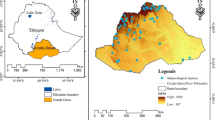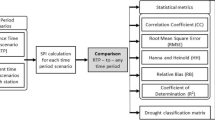Abstract
Rainfall rates and soil moisture content have been recognized as the most critical parameters in flood forecasts; the former known as forcing and the latter as the state variable. The main objective of this article is the incorporation of antecedent soil moisture information to reduce false flood warnings over Riyadh City, Saudi Arabia. The forcing variable was obtained from the Tropical Rainfall Measuring Mission (TRMM) Multi-satellite Precipitation Analysis (TMPA) Real Time (RT) data (3B42RT). Soil moisture (SM) information was obtained from Advanced Microwave Scanning Radiometer (AMSR-E) as the state variable. Long time series SM information (2002–2011) provided Cumulative Distribution Function (CDF) of SM. CDF with 90% was taken as the SM threshold value. Flooding is indicated for rainy dates exceeding the rain thresholds with the previous satellite overpass SM being greater than 90% CDF of the respective month. The methodology removed the false flood warnings substantially when compared to the flood warnings where SM information was absent. The method is robust and simple, and it can be applied on TRMM and AMSR-E follow on missions; like Global Precipitation Measurement (GPM) and Soil Moisture Active Passive (SMAP).





Similar content being viewed by others
References
Abushandi E (2016) Flash flood simulation for Tabuk City catchment, Saudi Arabia. Arab J Geosci 9:188. doi:10.1007/s12517-015-2192-x
Alamri YA (2011) Rains and floods in Saudi Arabia. Saudi Med J 32(3):311–313
Alfieri L, Thielen J (2012) A European precipitation index for extreme rain-storm and flash flood early warning. Meteorol Appl 22:3–13. doi:10.1002/met.1328
AlHassoun SA (2011) Developing an empirical formulae to estimate rainfall intensity in Riyadh region. Journal of King Saud University-Engineering Sciences 23:81–88
Almazroui M (2011a) Calibration of TRMM rainfall climatology over Saudi Arabia during 1998–2009. Atmos Res 400–414. doi:10.1016/J.atmosres.2010.11.006
Almazroui M (2011b) Sensitivity of a regional climate model on the simulation of high intensity rainfall events over the Arabian peninsula and around Jeddah. Theor Appl Climatol 104:261–276
Al-Turbak AS, Quraishi AA (1986) Regional flood frequency analysis for some selected basins in Saudi Arabia. In: Proceedings of International Symposium on Flood Frequency and Risk Analysis, Louisiana State University, Baton Rouge, La., Volume on Regional Flood Frequency Analysis, p 27–34
Asante KO, Dezanove RM, Artan G, Lietzow R, Verdin J (2007) Developing a flood monitoring system from remotely sensed data for the Limpopo Basin. IEEE Trans Geosci Remote Sens 45(6):1709–1714
Bashir B, Fouli H (2015) Studying te spatial distribution of maximum monthly rainfall in selected regoins of Saudi Arabia using geographic information systems. Arab J Geosci. doi:10.1007/s12517-015-1870-z
Borga M, Stoffel M, Marchi L, Marra F, Jakob M (2014) Hydrogeomorphic response to extreme rainfall in headwater systems: flash floods and debris flows. J Hydrol 518:194–205. doi:10.1016/j.jhydrol.2014.05.022
Fouli H, Al-Turbak AS, Bashir B, Loni OA (2016) Assessment of a water-harvesting site in Riyadh region of Kingdom of Saudi Arabia using hydrological analysis. Arab J Geosci 9:387
Global Change Observation Mission (GCOM) (2016) https://gcom-w1.jaxa.jp/auth.html. Last accesed 6 Mar 2016
Hamada A, Murayama Y, Takayabu YN (2014) Regional characteristics of extreme rainfall extracted from TRMM PR measurements. J Clim 27:8151–8169. doi:10.1175/Jcli-D-14-00107.1
Hapuarachchi HAP, Wang QJ, Pagano TC (2011) A review of advances in flash flood forecasting. Hydrol Process 25(18):2771–2784
Hong Y, Adler R, Negri A, Huffman G (2007) Flood and landslide applications of near real-time satellite rainfall products. Nat Hazards 43(2):285–294
Hong Y, Adler RF, Huffman GJ, Pierce H, Gebremichael M, Hossain F (2010) Applications of TRMM-based multi-satellite precipitation estimation for global runoff prediction: prototyping a global flood modeling system satellite rainfall applications for surface hydrology. Springer, Netherlands, pp 245–265
Javelle P, Fouchier C, Arnaud P, Lavabre J (2010) Flash flood warning at ungauged locations using radar and antecedent soil moisture estimations. J Hydrol 394(2010):267–274. doi:10.1016/j.jhydrol.2010.03.32
JAXA (2016) http://sharaku.eorc.jaxa.jp/AMSR/ov_amsre/index.html. Last accessed 6 Mar 2016
Kerr YH, Waldteufel P, Wigneron JP, Martinuzzi JM, Font J, Berger M (2001) Soil moisture retrieval from space: the soil moisture and ocean salinity (SMOS) mission. IEEE Trans Geosci Remote Sens 39:1729–1735
Khemi MM, Gutub S (2014) Assessment of remotely sensed precipitation products across the Saudi Arabia region. 6th International conference on water resources and arid environments, 16–17 December 2014, Riyadh, Saudi Arabia, pp 315–327
Leroux DJ, Pellarin T, Vischel T, Cohard JM, Gascon T, Gibon F, Malon A, Galle S, Peugeot C, Seguis L (2016) Assimilation of SMOS soil moisture into a distributed hydrological model and impacts on the water cycle variables over the Quémé catchment in Benin. Hydrol Earth Syst Sci 20:2827–2840. doi:10.5194/hess-20-2827-2016
Lievens H, Tomer SK, Al Bitar A, De Lannoy GJM,Drusch M, Dumedahe G, Hendricks Franssen JH,Kerr YH, Pan M, Roundyh JK,Vereeckenf H, Walker JP, Wood EF,Verhoest NEC, Pauwels VRN (2015) SMOS soil moisture assimilation for improved hydrologic simulation in the Murray Darling Basin, Australia. Remote Sens Environ 168. doi: 10.1016/j.rse.2015.06.025
Merz R, Blӧschl G (2009) A regional analysis of event runoff coefficients with respect to climate and catchment characteristics in Austria. Water Resour Res 45(1):WO1405. doi:10.1029/2008WR007163
Mishra S, Jain M, Singh V (2004) Evaluation of the SCS-CN-based model incorporating antecedent moisture. Water Resour Manag 18:567–589
Mladenova I, Lakshmi V, Jackson TJ, Walker JP, Merlin O, De Jeu RAM (2011) Validation of AMSR-E soil moisture using L-band airborne radiometer data from Natioinal airborne field experiment 2006. Remote Sens Environ 115(2011):2096–2103. doi:10.1016/j.rse.2011.04.011
Návar J (2013) Hydro-climatic variability and forest fires in Mexico’s northern temperate forests. Geofísica internacional 52(1):5–20
Návar J (2015) Hydro-climatic variability and perturbations in Mexico’s north-western temperate forests. Ecohydrology 8:1065–1072. doi:10.1002/eco,1564
Negri AJ, Burkardt N, Golden JH, Halverson JB, Huffman GJ, Larsen MC, McGinley JA, Updike RG, Verdin JP, Wieczorek GF (2005) The hurricane-flood-landslide continuum. Bull Am Meteorol Soc 86(9):1241–1247
Nikolopoulos EI, Anagnostou E, Borga M, Vivoni ER, Papadopoulos A (2011) Sensitivity of a mountain basin flash flood to initial wetness condition and rainfall variability. J Hydrol 402(2011):165–178. doi:10.1016/j.jhydrol.2010.12.020
Norbiato D, Borga N, Esposti SD, Gaume E, Anquetin S (2008) Flash flood warning based on rainfall thresholds and soil moisture conditions: an assessment for gauged and ungauged basins. J Hydrol 362:274–290. doi:10.1016/j.jhydrol.2008.08.023
PME (2015) http://jrcc.sa/climate_data_observatory_sa.php. Last accessed 14 Mar 2016
Sharif HO, Al-Juaidi FH, Al-Othman A, Al-Dousary I, Fadda E, Uddeen SJ, Elhassan A (2014) Flood hazards in an urbanizing watershed in Riyadh, Saudi Arabia. Geomatics, Natural Hazards and Risk. doi:10.1080/19475705.2014.945101
Srivastava PK, Han D, Ramirez MAR, Islam T (2013) Appraisal of SMOS soil moisture at a cahtchment scale in temperate maritime climate. J Hydrol 498:292–304. doi:10.1016/j.jhydrol.2013.06.021
Subyani AMMA (2010) Topographic, seasonal and aridity influence on rainfall variability in western Saudi Arabia. J Environ Hydrol 18(2):1–11
Subyani AM, Al-Ahmadi FS (2011) Rainfall-runoff modeling in the Al-Madinah area of Western Saudi Arabia. J Environ Hydrol, Volume 19, Paper 1
Tayfur G, Brocca L (2015) Fuzzy logic for rainfall-runoff modelling considering soil moisture. Water Resour Manag 29:3519–3533. doi:10.1007/s11269-015-1012-0
Tekeli AE, Fouli H (2016) Evaluation of TRMM satellite-based precipitation indexes for flood forecasting over Riyadh City, Saudi Arabia. J Hydrol 541:471–479. doi:10.1016/j.jhydrol.2016.01.014
Tombul M (2007) Mapping field soil moisture for hydrological modeling. Water Resour Manag 21:1865–1880. doi:10.1007/s11269-006-9134-z
TRMM (2015) http://trmm.gsfc.nasa.gov/3b42.html. Last accessed 14 Mar 2016
TRMM (2016) http://trmm.gsfc.nasa.gov/. Last accessed 23 Feb 2016
Viessman W, Lewis GL (2002) Introduction to hydrology. Prentice Hall
Wanders N, Pan M, Wood EF (2015) Correction of real time satellite precipitation with multi sensor satellite observations of land surface variables. Remote Sens Environ 160:206–221
Wardah T, Abu Bakar SH, Bardossy A, Maznorizan M (2008) Use of geostationary meteorological satellite images in convective rain estimation for flash-flood forecasting. J Hydrol 356(3–4):283–298
Zehe E, Sivapalan M (2009) Threshold behaviour in hydrological systems as (human) geo-ecosystems: manifestations, controls, implications. Hydrol Earth Syst Sci 13:1273–1297. doi:10.5194/hess-13-1273-2009
Zhuo L, Han D (2016) Could operational hydrological models be made compatible with satellite soil moisture observations? Hydrol Process 30:1637–1648. doi:10.1002/hyp.10804
Zhuo L, Han D, Dai Q, Islam T, Srivastava PK (2015) Apprasial of NLDAS-2 multi-model simulated soil moistures for hydrological modelling. Water Resour Manag 29:3503–3517. doi:10.1007/s11269-015-1011-1
Zipser EJ, Cecil DJ, Liu CT, Nesbitt SW, Yorty DP (2006) Where are the most intense thunderstorms on earth? B Am Meteorol Soc 87:1057–1071. doi:10.1175/Bams-87-8-1057
Acknowledgements
This research was supported by the Deanship of Scientific Research, College of Engineering Research Center at King Saud University, Riyadh, Kingdom of Saudi Arabia. The data providers of TRMM 3B42RT Version 7 and AMSR-E, GCOM, are also acknowledged. The authors would also like to thank Mr. Cory Albers, M. Sc., P. Eng. of Source2Source Inc., as well as Dr. Newfel Mazari of University of Texas at San Antonio for their thoughtful review and editing of the article.
Author information
Authors and Affiliations
Corresponding author
Rights and permissions
About this article
Cite this article
Tekeli, A.E., Fouli, H. Reducing False Flood Warnings of TRMM Rain Rates Thresholds over Riyadh City, Saudi Arabia by Utilizing AMSR-E Soil Moisture Information. Water Resour Manage 31, 1243–1256 (2017). https://doi.org/10.1007/s11269-017-1573-1
Received:
Accepted:
Published:
Issue Date:
DOI: https://doi.org/10.1007/s11269-017-1573-1




